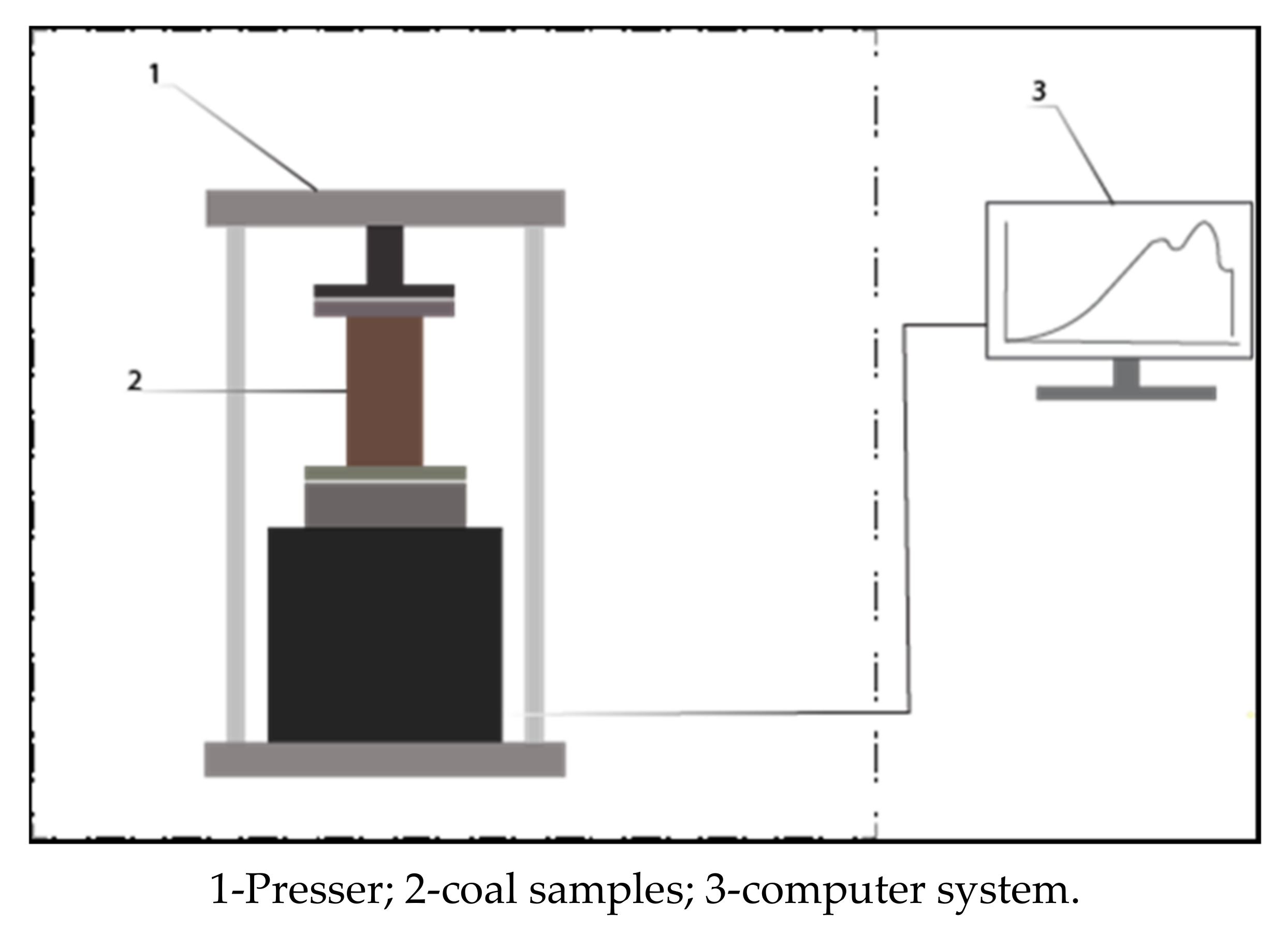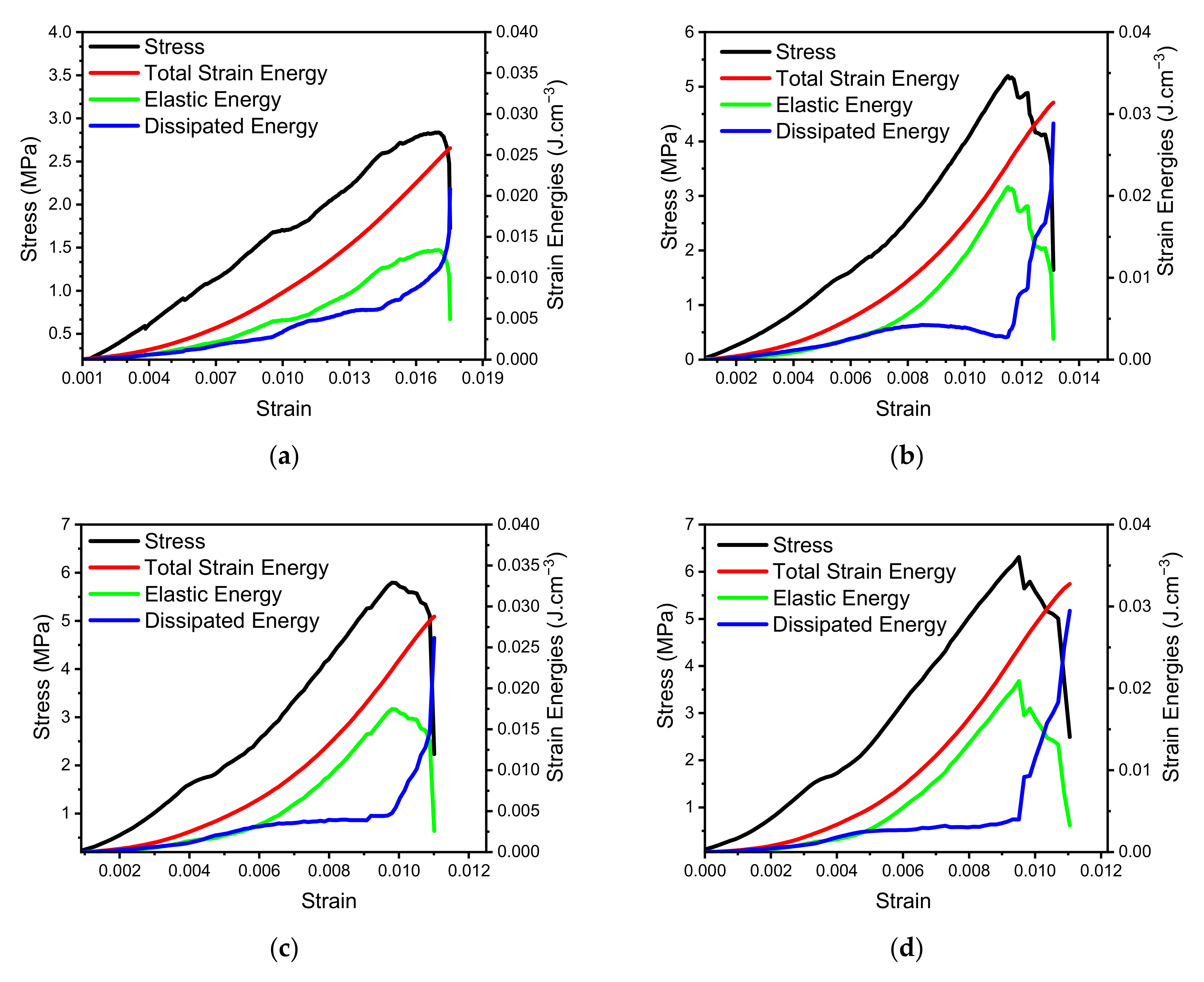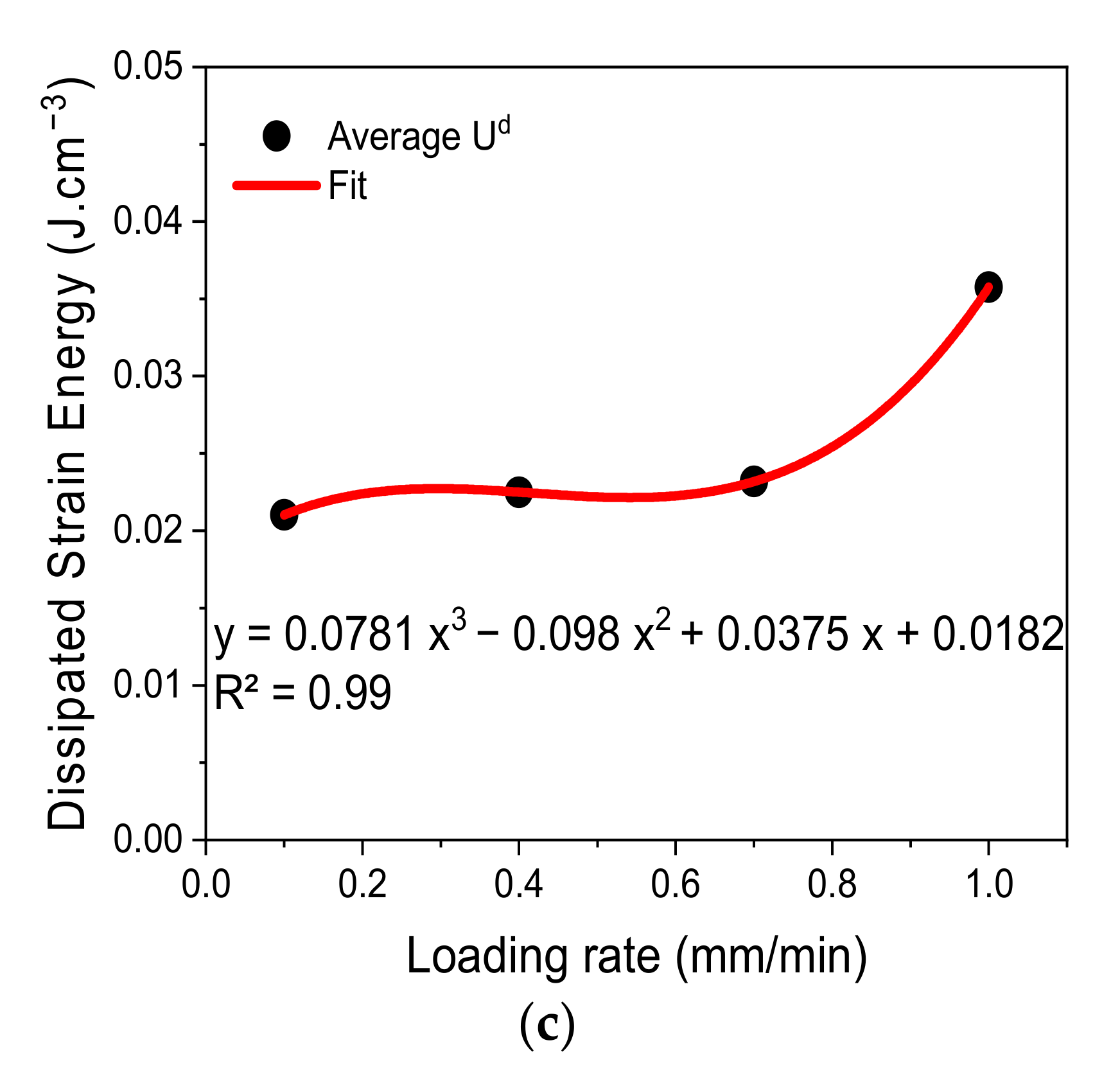Developing a New Bursting Liability Index Based on Energy Evolution for Coal under Different Loading Rates
Abstract
:1. Introduction
2. Materials and Methods
2.1. Sample Preparation
2.2. Experimental Instrument
3. Strain Energy
4. Rock Burst Indexes
4.1. Elastic Strain Energy Index
4.2. Bursting Energy Index
4.3. Dynamic Failure Time
4.4. Uniaxial Compressive Strength Index (Rc)
5. Experimental Results
5.1. Mechanical Properties
5.2. Strain Energy
5.3. Energy Modulus and Damage Variable Index for Coal Burst
5.4. Index Comparison
6. Discussion
7. Conclusions
- The stress-strain curve moves from ductile to brittle under different loading rates. Additionally, the elastic modulus, peak, and residual strength increase, while peak and residual strain decrease.
- The total strain energy, elastic strain energy, and dissipated strain energy at ultimate strength have a positive correlation with loading rates. The ∆Ud was used and suggested as an indicator for crack development and propagation during stress-strain curves based on the energy mechanism. Furthermore, the experimental results indicated that the ∆Ud increased with the loading rate.
- A new elastic modulus damage index (EDMI) was proposed and is based on the elastic modulus (damage factor) and energy liability. The EMDI was compared with available coal burst indexes (Wet, Ke, DT, and Rc), and the results show a good correlation determination factor.
- Based on the comparative analysis, it was proposed that the EMDI can be effectively used in monitoring coal bursting liability for the safe mining of deep coal deposits.
Author Contributions
Funding
Conflicts of Interest
References
- Feng, J.; Wang, E.; Chen, X.; Ding, H. Energy dissipation rate: An indicator of coal deformation and failure under static and dynamic compressive loads. Int. J. Min. Sci. Technol. 2018, 28, 397–406. [Google Scholar] [CrossRef]
- Jangara, H.; Ozturk, C.A. Longwall top coal caving design for thick coal seam in very poor strength surrounding strata. Int. J. Coal Sci. Technol. 2021, 8, 641–658. [Google Scholar] [CrossRef]
- Lian, X.; Hu, H.; Li, T.; Hu, D. Main geological and mining factors affecting ground cracks induced by underground coal mining in Shanxi Province, China. Int. J. Coal Sci. Technol. 2020, 7, 362–370. [Google Scholar] [CrossRef] [Green Version]
- Zuo, J.; Wang, J.; Jiang, Y. Macro/meso failure behavior of surrounding rock in deep roadway and its control technology. Int. J. Coal Sci. Technol. 2019, 6, 301–319. [Google Scholar] [CrossRef] [Green Version]
- Gao, R.; Kuang, T.; Zhang, Y.; Zhang, W.; Quan, C. Controlling mine pressure by subjecting high-level hard rock strata to ground fracturing. Int. J. Coal Sci. Technol. 2021, 8, 1336–1350. [Google Scholar] [CrossRef]
- Li, C.; Guo, D.; Zhang, Y.; An, C. Compound-mode crack propagation law of PMMA semicircular-arch roadway specimens under impact loading. Int. J. Coal Sci. Technol. 2021, 8, 1302–1315. [Google Scholar] [CrossRef]
- Liu, B.; Zhao, Y.; Zhang, C.; Zhou, J.; Li, Y.; Sun, Z. Characteristic strength and acoustic emission properties of weakly cemented sandstone at different depths under uniaxial compression. Int. J. Coal Sci. Technol. 2021, 8, 1288–1301. [Google Scholar] [CrossRef]
- Batugin, A.; Wang, Z.; Su, Z.; Sidikovna, S.S. Combined support mechanism of rock bolts and anchor cables for adjacent roadways in the external staggered split-level panel layout. Int. J. Coal Sci. Technol. 2021, 8, 659–673. [Google Scholar] [CrossRef]
- Brodny, J.; Tutak, M. Exposure to harmful dusts on fully powered longwall coal mines in Poland. Int. J. Environ. Res. Public Health 2018, 15, 1846. [Google Scholar] [CrossRef] [PubMed] [Green Version]
- Lu, Z.; Ju, W.; Gao, F.; Feng, Y.; Sun, Z.; Wang, H.; Yi, K. A New Bursting Liability Evaluation Index for Coal—The Effective Elastic Strain Energy Release Rate. Energies 2019, 12, 3734. [Google Scholar] [CrossRef] [Green Version]
- Chen, B. Stress-induced trend: The clustering feature of coal mine disasters and earthquakes in China. Int. J. Coal Sci. Technol. 2020, 7, 676–692. [Google Scholar] [CrossRef]
- Chen, Y.; Zuo, J.; Liu, D.; Li, Y.; Wang, Z. Experimental and numerical study of coal-rock bimaterial composite bodies under triaxial compression. Int. J. Coal Sci. Technol. 2021, 8, 908–924. [Google Scholar] [CrossRef]
- Zhang, S.; Lu, L.; Wang, Z.; Wang, S. A physical model study of surrounding rock failure near a fault under the influence of footwall coal mining. Int. J. Coal Sci. Technol. 2021, 8, 626–640. [Google Scholar] [CrossRef]
- Lawson, H.; Weakley, A.; Miller, A. Dynamic failure in coal seams: Implications of coal composition for bump susceptibility. Int. J. Min. Sci. Technol. 2016, 26, 3–8. [Google Scholar] [CrossRef]
- Tao, Z.; Zhang, H.; Chen, Y.; Jiang, C. Support principles of NPR bolt/cable and control techniques of large-deformation disasters. Int. J. Min. Sci. Technol. 2016, 26, 967–973. [Google Scholar] [CrossRef]
- Yuan, Q.; Xie, G.; Wang, L.; Jiao, Z.; Zou, P.; Liu, H.; Khan, N.M. Experimental Study on Stress Uniformity and Deformation Behavior of Coals with Different Length-to-Diameter Ratios under Dynamic Compression. Shock Vib. 2021, 2021, 6675200. [Google Scholar] [CrossRef]
- Cai, M. Prediction and prevention of rockburst in metal mines—A case study of Sanshandao gold mine. J. Rock Mech. Geotech. Eng. 2016, 8, 204–211. [Google Scholar] [CrossRef]
- Li, S.; Feng, X.-T.; Li, Z.; Chen, B.; Zhang, C.; Zhou, H. In situ monitoring of rockburst nucleation and evolution in the deeply buried tunnels of Jinping II hydropower station. Eng. Geol. 2012, 137, 85–96. [Google Scholar] [CrossRef]
- Zhou, H.; Meng, F.; Zhang, C.; Hu, D.; Yang, F.; Lu, J. Analysis of rockburst mechanisms induced by structural planes in deep tunnels. Bull. Eng. Geol. Environ. 2015, 74, 1435–1451. [Google Scholar] [CrossRef]
- Wang, J.; Zhang, J. Preliminary engineering application of microseismic monitoring technique to rockburst prediction in tunneling of Jinping II project. J. Rock Mech. Geotech. Eng. 2010, 2, 193–208. [Google Scholar]
- Zhang, H.; Chen, L.; Chen, S.; Sun, J.; Yang, J. The spatiotemporal distribution law of microseismic events and rockburst characteristics of the deeply buried tunnel group. Energies 2018, 11, 3257. [Google Scholar] [CrossRef] [Green Version]
- Zhang, Y.; Feng, X.-T.; Yang, C.; Zhang, X.; Sharifzadeh, M.; Wang, Z. Fracturing evolution analysis of Beishan granite under true triaxial compression based on acoustic emission and strain energy. Int. J. Rock Mech. Min. Sci. 2019, 117, 150–161. [Google Scholar] [CrossRef]
- Wang, J.; Ning, J.; Jiang, J.; Bu, T.; Shi, X. Research on the energy criterion for rockbursts induced by broken hard and thick rock strata and its application. Geotech. Geol. Eng. 2017, 35, 731–746. [Google Scholar] [CrossRef]
- Zhang, Z.; Li, H.; Yang, H.; Wang, B. Failure modes and face instability of shallow tunnels under soft grounds. Int. J. Damage Mech. 2019, 28, 566–589. [Google Scholar] [CrossRef]
- Dong, X.; Wu, Y.; Cao, K.; Muhammad Khan, N.; Hussain, S.; Lee, S.; Ma, C. Analysis of Mudstone Fracture and Precursory Characteristics after Corrosion of Acidic Solution Based on Dissipative Strain Energy. Sustainability 2021, 13, 4478. [Google Scholar] [CrossRef]
- Chi, X.; Yang, K.; Wei, Z. Breaking and mining-induced stress evolution of overlying strata in the working face of a steeply dipping coal seam. Int. J. Coal Sci. Technol. 2021, 8, 614–625. [Google Scholar] [CrossRef]
- Kim, B.-H.; Walton, G.; Larson, M.K.; Berry, S. Investigation of the anisotropic confinement-dependent brittleness of a Utah coal. Int. J. Coal Sci. Technol. 2021, 8, 274–290. [Google Scholar] [CrossRef]
- Yang, D.; Ning, Z.; Li, Y.; Lv, Z.; Qiao, Y. In situ stress measurement and analysis of the stress accumulation levels in coal mines in the northern Ordos Basin, China. Int. J. Coal Sci. Technol. 2021, 8, 1316–1335. [Google Scholar] [CrossRef]
- Lou, J.; Gao, F.; Yang, J.; Ren, Y.; Li, J.; Wang, X.; Yang, L. Characteristics of evolution of mining-induced stress field in the longwall panel: Insights from physical modeling. Int. J. Coal Sci. Technol. 2021, 8, 938–955. [Google Scholar] [CrossRef]
- Wang, J.-A.; Park, H. Comprehensive prediction of rockburst based on analysis of strain energy in rocks. Tunn. Undergr. Space Technol. 2001, 16, 49–57. [Google Scholar] [CrossRef]
- Ding, X.; Xiao, X.-C.; Wu, D.; Lv, X.-F. Mechanical properties and charge signal characteristics in coal material failure under different loading paths. Int. J. Coal Sci. Technol. 2019, 6, 138–149. [Google Scholar] [CrossRef]
- Tian, Z.; Tang, C.A.; Liu, Y.; Tang, Y. Zonal disintegration test of deep tunnel under plane strain conditions. Int. J. Coal Sci. Technol. 2020, 7, 337–349. [Google Scholar] [CrossRef]
- Zhou, A.; Zhang, M.; Wang, K.; Elsworth, D. Near-source characteristics of two-phase gas–solid outbursts in roadways. Int. J. Coal Sci. Technol. 2021, 8, 685–696. [Google Scholar] [CrossRef]
- Cao, K.W.; Khan, N.M.; Liu, W.; Hussain, S.; Zhu, Y.G.; Cao, Z.T.; Bian, Y.C. Prediction Model of Dilatancy Stress Based on Brittle Rock: A Case Study of Sandstone. Arab. J. Sci. Eng. 2021, 46, 2165–2176. [Google Scholar] [CrossRef]
- Cook, N.G.W. The Design Of Underground Excavations. In Proceedings of the The 8th U.S. Symposium on Rock Mechanics (USRMS), Minneapolis, MN, USA, 15–17 September 1966. [Google Scholar]
- Tan, Y.-l.; Guo, W.-y.; Gu, Q.-h.; Zhao, T.-b.; Yu, F.-h.; Hu, S.-c.; Yin, Y.-c. Research on the Rockburst Tendency and AE Characteristics of Inhomogeneous Coal-Rock Combination Bodies. Shock Vib. 2016, 2016, 9271434. [Google Scholar] [CrossRef] [Green Version]
- Singh, S. Burst energy release index. Rock Mech. Rock Eng. 1988, 21, 149–155. [Google Scholar] [CrossRef]
- Weng, L.; Huang, L.; Taheri, A.; Li, X. Rockburst characteristics and numerical simulation based on a strain energy density index: A case study of a roadway in Linglong gold mine, China. Tunn. Undergr. Space Technol. 2017, 69, 223–232. [Google Scholar] [CrossRef]
- Beck, D.; Brady, B. Evaluation and application of controlling parameters for seismic events in hard-rock mines. Int. J. Rock Mech. Min. Sci. 2002, 39, 633–642. [Google Scholar] [CrossRef]
- Jiang, Q.; Feng, X.-T.; Xiang, T.-B.; Su, G.-S. Rockburst characteristics and numerical simulation based on a new energy index: A case study of a tunnel at 2500 m depth. Bull. Eng. Geol. Environ. 2010, 69, 381–388. [Google Scholar] [CrossRef]
- Xu, J.; Jiang, J.; Xu, N.; Liu, Q.; Gao, Y. A new energy index for evaluating the tendency of rockburst and its engineering application. Eng. Geol. 2017, 230, 46–54. [Google Scholar] [CrossRef]
- Dai, S.; Wang, X.; Pan, Y.; Liu, L. Experimental study on the evaluation of coal burst tendency utilizing modulus index. China Coal Soc. 2019, 44, 1726–1731. [Google Scholar]
- Zhou, Y.; Sheng, Q.; Li, N.; Fu, X. The influence of strain rate on the energy characteristics and damage evolution of rock materials under dynamic uniaxial compression. Rock Mech. Rock Eng. 2020, 53, 3823–3834. [Google Scholar] [CrossRef]
- Zhang, H.; Zhu, Y.; Chen, L.; Hu, W.; Chen, S. The prevention and control mechanism of rockburst hazards and its application in the construction of a deeply buried tunnel. Appl. Sci. 2019, 9, 3629. [Google Scholar] [CrossRef] [Green Version]
- Dong, W.; Zhao, X.; Zhou, X.; Yuan, W. Effects of moisture gradient of concrete on fracture process in restrained concrete rings: Experimental and numerical. Eng. Fract. Mech. 2019, 208, 189–208. [Google Scholar] [CrossRef]
- Naji, A.M.; Rehman, H.; Emad, M.Z.; Yoo, H. Impact of shear zone on rockburst in the deep neelum-jehlum hydropower tunnel: A numerical modeling approach. Energies 2018, 11, 1935. [Google Scholar] [CrossRef] [Green Version]
- Liu, T.; Lin, B.; Fu, X.; Liu, A. Mechanical criterion for coal and gas outburst: A perspective from multiphysics coupling. Int. J. Coal Sci. Technol. 2021, 8, 1423–1435. [Google Scholar] [CrossRef]
- GB/T 25217.2-2010; Classification and Laboratory Test Method on Bursting Liability of Coal. Standards Press of China: Beijing, China, 2010. (In Chinese)
- Kidybiński, A. Bursting liability indices of coal. Int. J. Rock Mech. Min. Sci. Geomech. Abstr. 1981, 18, 295–304. [Google Scholar] [CrossRef]
- Yang, X.; Ren, T.; Tan, L.; Remennikov, A.; He, X. Developing coal burst propensity index method for Australian coal mines. Int. J. Min. Sci. Technol. 2018, 28, 783–790. [Google Scholar] [CrossRef]
- Goodman, R.E. Introduction to Rock Mechanics; Wiley: New York, NY, USA, 1989; Volume 2. [Google Scholar]
- Zhang, W.; Wang, S.; Wu, Y.; Qu, X. To determine proneness of coal burst by dynamic failure time. Coal Sci. Technol. 1986, 14, 31–34. [Google Scholar]
- Qi, Q.; Peng, Y.; Li, H.; Li, J.; Wang, Y.; Li, C. Study of bursting liability of coal and rock. Chin. J. Rock Mech. Eng. 2011, 30, 2736–2742. [Google Scholar]
- Wang, H.; Yang, T.-H.; Liu, H.-L.; Zhao, Y.-C. Deformation and acoustic emission characteristics of dry and saturated sand under cyclic loading and unloading process. J. Northeast. Univ. (Nat. Sci.) 2016, 37, 1161. [Google Scholar]
- Xiao, W.; Zhang, D.; Cai, Y.; Chu, Y. Study on loading rate dependence of the coal failure process based on uniaxial compression test. Pure Appl. Geophys. 2020, 177, 4925–4941. [Google Scholar] [CrossRef]
- Gao, F.; Kang, H. Experimental study on the residual strength of coal under low confinement. Rock Mech. Rock Eng. 2017, 50, 285–296. [Google Scholar] [CrossRef]
- Xie, H.; Li, L.; Peng, R.; Ju, Y. Energy analysis and criteria for structural failure of rocks. J. Rock Mech. Geotech. Eng. 2009, 1, 11–20. [Google Scholar] [CrossRef] [Green Version]
- Song, Z.; Ji, H.; Liu, Z.; Sun, L. Study on the critical stress threshold of weakly cemented sandstone damage based on the renormalization group method. Int. J. Coal Sci. Technol. 2020, 7, 693–703. [Google Scholar] [CrossRef] [Green Version]
- Chang, J.; He, K.; Pang, D.; Li, D.; Li, C.; Sun, B. Influence of anchorage length and pretension on the working resistance of rock bolt based on its tensile characteristics. Int. J. Coal Sci. Technol. 2021, 8, 1384–1399. [Google Scholar] [CrossRef]
- Peng, K.; Shi, S.; Zou, Q.; Mou, J.; Yu, J.; Zhang, Y.; Cheng, Y. Characteristics of energy storage and dissipation of coal under one-time cyclic load. Energy Sci. Eng. 2020, 8, 3117–3135. [Google Scholar] [CrossRef]
- Luo, S.; Gong, F. Linear Energy Storage and Dissipation Laws of Rocks Under Preset Angle Shear Conditions. Rock Mech. Rock Eng. 2020, 53, 3303–3323. [Google Scholar] [CrossRef]










| Index | Wet | DT (ms) | Rc | Ke |
|---|---|---|---|---|
| None | <2 | >500 | <7 | <1.5 |
| Low | 2 ≤ Wet < 5 | 50 < DT ≤ 500 | 7 ≤ Rc < 14 | 1.5 ≤ Ke < 5 |
| High | ≥5 | ≤50 | ≥14 | ≥5 |
| Index | Wet | DT (ms) | Rc | Ke | EMDI |
|---|---|---|---|---|---|
| None | <2 | >500 | <7 | <1.5 | <0.91 |
| Low | 2 ≤ Wet < 5 | 50 < DT ≤ 500 | 7 ≤ Rc < 14 | 1.5 ≤ Ke < 5 | 0.91 ≤ EMDI < 1.93 |
| High | ≥5 | ≤50 | ≥14 | ≥5 | >1.93 |
| Indexes | Loading Rate (mm/min) | Bursting Liability Evaluation with Different Loading Rate | ||||||
|---|---|---|---|---|---|---|---|---|
| 0.1 | 0.4 | 0.7 | 1 | 0.1 | 0.4 | 0.7 | 1 | |
| Wet | 0.070 | 1.730 | 3.100 | 4.700 | None | None | Weak | Weak |
| DT (ms) | 30813 | 23781 | 11328 | 9012 | None | None | None | None |
| Rc | 2.837 | 5.4492 | 5.7876 | 6.314 | None | None | None | None |
| Ke | 1.300 | 2.650 | 3.970 | 4.970 | None | Weak | Weak | Weak |
| EDMI | 0.003 | 0.820 | 1.310 | 1.860 | None | None | Weak | Weak |
Publisher’s Note: MDPI stays neutral with regard to jurisdictional claims in published maps and institutional affiliations. |
© 2022 by the authors. Licensee MDPI, Basel, Switzerland. This article is an open access article distributed under the terms and conditions of the Creative Commons Attribution (CC BY) license (https://creativecommons.org/licenses/by/4.0/).
Share and Cite
Khan, N.M.; Ahmad, M.; Cao, K.; Ali, I.; Liu, W.; Rehman, H.; Hussain, S.; Rehman, F.U.; Ahmed, T. Developing a New Bursting Liability Index Based on Energy Evolution for Coal under Different Loading Rates. Sustainability 2022, 14, 1572. https://doi.org/10.3390/su14031572
Khan NM, Ahmad M, Cao K, Ali I, Liu W, Rehman H, Hussain S, Rehman FU, Ahmed T. Developing a New Bursting Liability Index Based on Energy Evolution for Coal under Different Loading Rates. Sustainability. 2022; 14(3):1572. https://doi.org/10.3390/su14031572
Chicago/Turabian StyleKhan, Naseer Muhammad, Maqsood Ahmad, Kewang Cao, Imtiaz Ali, Wei Liu, Hafeezur Rehman, Sajjad Hussain, Faheem Ur Rehman, and Tufail Ahmed. 2022. "Developing a New Bursting Liability Index Based on Energy Evolution for Coal under Different Loading Rates" Sustainability 14, no. 3: 1572. https://doi.org/10.3390/su14031572







